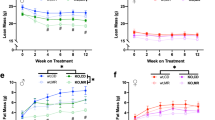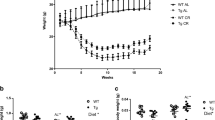Abstract
It has been described that dietary cysteine reverses many of the beneficial changes induced by methionine restriction in aging rodents. In this investigation male Wistar rats were subjected to diets low in methionine, supplemented with cysteine, or simultaneously low in methionine and supplemented with cysteine. The results obtained in liver showed that cysteine supplementation reverses the decrease in mitochondrial ROS generation induced by methionine restriction at complex I. Methionine restriction also decreased various markers of oxidative and non-oxidative stress on mitochondrial proteins which were not reversed by cysteine. Instead, cysteine supplementation also lowered protein damage in association with decreases in mTOR activation. The results of the present study add the decrease in mitochondrial ROS production to the various beneficial changes induced by methionine restriction that are reversed by cysteine dietary supplementation.



Similar content being viewed by others
Abbreviations
- AIF:
-
Apoptosis-inducing factor
- CEL:
-
Carboxyethyl-lysine
- CML:
-
Carboxymethyl-lysine
- CMC:
-
S-(carboxymethyl)-cysteine
- ERK:
-
Extracellular-signal regulated kinase
- GSA:
-
Glutamic semialdehyde
- MDA:
-
Malondialdehyde-lysine
- MetR:
-
Methionine restriction
- mitROSp:
-
Mitochondrial ROS production
- mTOR:
-
Mammalian target of rapamycin
- ROS:
-
Reactive oxygen species
- SC:
-
Succinyl-cysteine
References
Ables GP, Perrone CE, Orentreich D, Orentreich N (2012) Methionine-restricted C57BL/6J mice are resistant to diet-induced obesity and insulin resistance but have low bone density. PLoS One 7:e51357. doi:10.1371/journal.pone.0051357
Barja G (2002) The quantitative measurement of H2O2 generation in isolated mitochondria. J Bioenerg Biomembr 34:227–233
Barja G (2004) Free radicals and aging. Trends Neurosci 27:595–600
Barja G (2013) Updating the mitochondrial free radical theory of aging: an integrated view, key aspects and confounding concepts. Antioxid Redox Signal 19:420–1445
Caro P, Gómez J, López-Torres M, Sánchez I, Naudí A, Jove M, Pamplona R, Barja G (2008) Forty percent and eighty percent methionine restriction decrease mitochondrial ROS generation and oxidative stress in rat liver. Biogerontology 9:183–196
Castello L, Maina M, Testa G, Cavallini G, Biasi F, Donati A, Leonarduzzi G, Bergamini E, Poli G, Chiarpotto E (2011) Mech Ageing Dev 132:305–314
Cavuoto P, Fenech MF (2012) A review of methionine dependency and the role of methionine restriction in cancer growth control and life-span extension. Cancer Treat Rev 38:726–736
Dhabi JM, Monte PL, Wingo J, Rowley BC, Cao SX, Wadford RL, Spindler SR (2001) Caloric restriction alters the feeding response of key metabolic enzyme genes. Mech Ageing Dev 122:1033–1048
Di Simplicio P, Franconi F, Frosalí S, Di Giuseppe D (2003) Thiolation and nitrosation of cysteines in biological fluids and cells. Amino Acids 25:323–339
Elshorbagy AK, Nurk E, Gjesdal CG, Tell GS, Ueland PM, Nygård O, Tverdal A, Vollset SE, Refsum H (2008) Homocysteine, cysteine, and body composition in the Hordaland Homocysteine Study: does cysteine link amino acid and lipid metabolism? Am J Clin Nutr 88:738–746
Elshorbagy AK, Valdivia-Garcia M, Refsum H, Smith AD, Mattocks DA, Perrone CE (2010) Sulfur amino acids in methionine-restricted rats: hyperhomocysteinemia. Nutrition 26:1201–1204
Elshorbagy AK, Valdivia-Garcia M, Mattocks DA, Plummer JD, Smith AD, Drevon CA, Refsum H, Perrone CE (2011) Cysteine supplementation reverses methionine restriction effects on rat adiposity: significance of stearoyl-coenzyme A desaturase. J Lipid Res 52:104–112
Elshorbagy AK, Valdivia-Garcia M, Mattocks DA, Plummer JD, Orentreich DS, Orentreich N, Refsum H, Perrone CE (2013) Effect of taurine and N-acetylcysteine on methionine restriction-mediated adiposity resistance. Metabolism 62:509–517
Gómez A, Sánchez-Roman I, Gomez J, Cruces J, Mate I, Lopez-Torres M, Naudi A, Portero-Otin M, Pamplona R, De la Fuente M, Barja G (2014) Life-long treatment with atenolol decreases membrane fatty acid unsaturation and oxidative stress in heart and skeletal muscle mitochondria, and improves immunity and behaviour, without changing mice longevity. Aging Cell 13:551–560
Gonzalo H, Brieva L, Tatzber F, Jové M, Cacabelos D, Cassanyé A, Lanau-Angulo L, Boada J, Serrano JC, González C, Hernández L, Peralta S, Pamplona R, Portero-Otin M (2012) Lipidome analysis in multiple sclerosis reveals protein lipoxidative damage as a potential pathogenic mechanism. J Neurochem 23:622–634
Grandison RC, Piper MDW, Partridge L (2009) Amino acid imbalance explains extension of life span by dietary restriction in Drosophila. Nature 462:1061–1064
Gredilla R, Barja G (2005) The role of oxidative stress in relation to caloric restriction and longevity. Endocrinology 146:3713–3717
Harman D (1972) The biological clock: the mitochondria. J Am Geriatr Soc 20:145–147
Huang TH, Lewis JL, Lin HS, Kuo LT, Mao SW, Tai YS, Chang MS, Ables GP, Perrone CE, Yang RS (2014) A methionine-restricted diet and endurance exercise decrease bone mass and extrinsic strength but increase intrinsic strength in growing male rats. J Nutr 144:621–630
Johnson JE, Johnson FB (2014) Methionine restriction activates the retrograde response and confers both stress tolerance and lifespan extension to yeast, mouse and human cells. PLoS One 9:e97729. doi:10.1371/journal.pone.0097729
Johnson SC, Sangesland M, Kaeberlein M, Rabinonitch PS (2015) Modulating mTOR in aging and health. Interdiscip Top Gerontol 40:107–127
Kabil H, Kabil O, Banerjee R, Harshman LG, Pletcher SD (2011) Increased transulfuration mediates longevity and dietary restriction in Drosophila. PNAS 108:16831–16836
Koziek R, Ruckenstuhl C, Albertini E, Neuhaus M, Netzberger C, Bust M, Madeo F, Wiesner RJ, Jansen-Dürr P (2014) Methionine restriction slows down senescence in human diploid fibroblasts. Aging Cell 13:1038–1048
Lee BC, Kaya A, Ma S, Kim G, Gerashchenko MV, Yim SH, Hu Z, Harshman LG, Gladyshev VN (2014) Methionine restriction extends lifespan of Drosophila melanogaster under conditions of low amino-acid status. Nat Commun 5:3592. doi:10.1038/ncomms4592
López-Torres M, Barja G (2008) Lowered methionine ingestion as responsible for the decrease in rodent mitochondrial oxidative stress in protein and dietary restriction. Possible implications for humans. Biochim Biophys Acta 1780:1337–1347
Maddineni S, Nichenametla S, Sinha R, Wilson RP, Richie JP Jr (2013) Methionine restriction affects oxidative stress and glutathione-related redox pathways in the rat. Exp Biol Med 238:392–399
Malloy VL, Krajcik RA, Bailey SJ, Hristopoulos G, Plummer JD, Orentreich N (2006) Methionine restriction decreases visceral fat mass and preserves insulin action in aging male Fischer 344 rats independent of energy restriction. Aging Cell 5:305–314
Malloy VL, Perrone CE, Mattocks DA, Ables GP, Caliendo NS, Orentreich DS, Orentreich N (2013) Methionine restriction prevents the progression of hepatic steatosis in leptin-deficient obese mice. Metabolism 62:1651–1661
Martínez A, Portero-Otin M, Pamplona R, Ferrer I (2010) Protein targets of oxidative damage in human neurodegenerative diseases with abnormal protein aggregates. Brain Pathol 20:281–297
Merkley ED, Metz TO, Smith RD, Baynes JW, Frizzell N (2014) The succinated proteome. Mass Spectrom Rev 33:98–109
Miller RA, Buehner G, Chang Y, Harper JM, Sigler R, Smith-Wheelock M (2005) Methionine-deficient diet extends mouse lifespan, slows immune and lens aging, alters glucose, T4, IGF-I and insulin levels, and increases hepatocyte MIF levels and stress resistance. Aging Cell 4:119–125
Min KJ, Tatar M (2006) Restriction of amino acids extends lifespan in Drosophila melanogaster. Mech Ageing Dev 127:643–646
Naudí A, Jove M, Cacabelos D, Ayala V, Cabre R, Caro P, Gomez J, Portero-Otín M, Barja G, Pamplona R (2013) Formation of S-(carboxymethyl)-cysteine in rat liver mitochondrial proteins:effects of caloric and methionine restriction. Amino Acids 44:361–371
Pamplona R, Portero-Otín M, Requena J, Gredilla R, Barja G (2002) Oxidative, glycoxidative and lipoxidative damage to rat heart mitochondrial proteins is lower after four months of caloric restriction than in age-matched controls. Mech Ageing Dev 123:1437–1446
Pamplona R, Dalfó E, Ayala V, Bellmunt MJ, Prat J, Ferrer I, Portero-Otín M (2005) Proteins in human brain cortex are modified by oxidation, glycoxidation, and lipoxidation. Effects of Alzheimer disease and identification of lipoxidation targets. J Biol Chem 280:21522–21530
Perrone CE, Mattocks DA, Plummer JD, Chittur SV, Mohney R, Vignola K, Orentreich DS, Orentreich N (2012) Genomic and metabolic responses to methionine-restricted and methionine-restricted, cysteine-supplemented diets in Fischer 344 rat inguinal adipose tissue, liver and quadriceps muscle. J Nutrigenet Nutrigenomics 5:132–157
Perrone CE, Malloy VL, Orentreich DS, Orentreich N (2013) Metabolic adaptations to methionine restriction that benefit health and lifespan in rodents. Exp Gerontol 48:654–660
Petti AA, Crutchfield CA, Rabinowitz JD, Botstein D (2011) Survival of starving yeast is correlated with oxidative stress response and nonrespiratory mitochondrial function. PNAS 108:E1089–E1098
Richie JP Jr, Leutzinger Y, Parthasarathy S, Malloy V, Orentreich N, Zimmerman JA (1994) Methionine restriction increases blood glutathione and longevity in F344 rats. FASEB J 8:1302–1307
Ruckenstuhl C, Netzberger C, Entfellner I, Carmona-Gutierrez D, Kickenweiz T, Stekovic S, Gleixner C, Schmid C, Klug L, Sorgo AG, Eisenberg T, Büttner S, Mariño G, Koziel R, Jansen-Dürr P, Fröhlich KU, Kroemer G, Madeo F (2014) Lifespan extension by methionine restriction requires autophagy-dependent vacuolar acidification. PLoS Genet 10:e1004347. doi:10.1371/journal.pgen.1004347
Sanchez-Roman I, Barja G (2013) Regulation of longevity and oxidative stress by nutritional interventions: role of methionine restriction. Exp Gerontol 48:1030–1042
Sanz A, Barja G (2006) Estimation of the rate of production of oxygen radicals by mitochondria. In: Conn M (ed) Handbook of models for human aging. Academic, New York, pp 183–189
Sanz A, Caro P, Barja G (2004) Protein restriction without strong caloric restriction decreases mitochondrial oxygen radical production and oxidative DNA damage in rat liver. J Bioenerg Biomembr 36:545–552
Sanz A, Gómez J, Caro P, Barja G (2006a) Carbohydrate restriction does not change mitochondrial free radical generation and oxidative DNA damage. J Bioenerg Biomembr 38:327–333
Sanz A, Caro P, Gómez J, Barja G (2006b) Effect of lipid restriction on mitochondrial free radical production and oxidative DNA damage. Ann NY Acad Sci 1067:200–209
Sun L, Amir A, Akha S, Millar RA, Harper J (2009) Life-span extension in mice by preweaning food restriction and by methionine restriction in middle age. J Gerontol A Biol Sci Med Sci 64A:711–722
Taylor ER, Hurrell F, Shannon RJ, Lin TK, Hirst J, Murphy MP (2003) Reversible glutathionylation of complex I increases mitochondrial superoxide formation. J Biol Chem 278:19603–19610
Thomas SA, Storey KB, Baynes JW, Frizzell N (2012) Tissue distribution of S-(2-succino)cysteine (2SC), a biomarker of mitochondrial stress in obesity and diabetes. Obesity (Silver Spring) 20:263–269
Thorpe SR, Baynes JW (2003) Maillard reaction products in tissue proteins: new products and new perspectives. Amino Acids 25:275–281
Vahsen N, Candé C, Brière JJ, Bénit P, Joza N, Larochette N, Mastroberardino PG, Pequignot MO, Casares N, Lazar V, Feraud O, Debili N, Wissing S, Engelhardt S, Madeo F, Piacentini M, Penninger JM, Schägger H, Rustin P, Kroemer G (2004) AIF deficiency compromises oxidative phosphorylation. EMBO J 23:4679–4689
Wanders D, Ghosh S, Stone KP, Van NT, Gettys TW (2014) Transcriptional impact of dietary methionine restriction on systemic inflammation: relevance to biomarkers of metabolic disease during aging. Biofactors 40:3–26
Wei Y, Zhang YJ, Cai Y (2013) Growth or longevity: the TOR’s decision on lifespan regulation. Biogerontology 14:353–363
Yan L, Vatner DE, O’Connor JP, Ivessa A, Ge H, Chen W, Hirotani S, Ishikawa Y, Sadoshima J, Vatner SF (2007) Type 5 adenylyl cyclase disruption increases longevity and protects against stress. Cell 130:247–258
Acknowledgments
This investigation was supported by grants from the Spanish Ministry of Economy and Competitiveness (BFU2009-118/79BFI, RD12/0043/0018, PI1300584, and PI1400328), and the Autonomous Government of Catalonia (2014SGR168) to R. Pamplona; and from the Spanish Ministry of Economy and Competitiveness (BFU 2011-23888) to G. Barja. A. Gomez received a pre-doctoral fellowship from the Spanish Government.
Author information
Authors and Affiliations
Corresponding author
Rights and permissions
About this article
Cite this article
Gomez, A., Gomez, J., Torres, M.L. et al. Cysteine dietary supplementation reverses the decrease in mitochondrial ROS production at complex I induced by methionine restriction. J Bioenerg Biomembr 47, 199–208 (2015). https://doi.org/10.1007/s10863-015-9608-x
Received:
Accepted:
Published:
Issue Date:
DOI: https://doi.org/10.1007/s10863-015-9608-x




